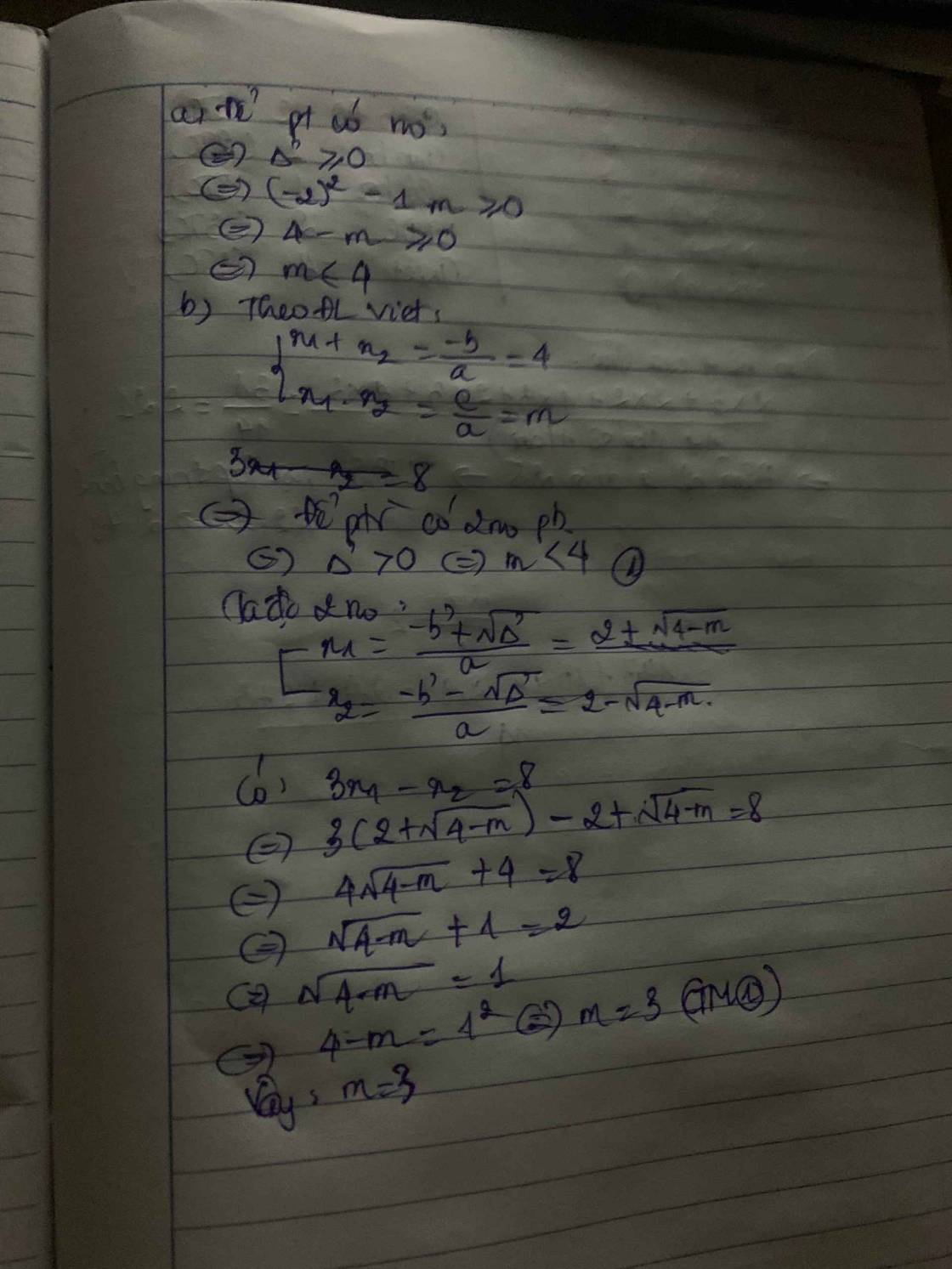
Hãy nhập câu hỏi của bạn vào đây, nếu là tài khoản VIP, bạn sẽ được ưu tiên trả lời.



a: \(\Leftrightarrow\left(2m-4\right)^2-4\left(m^2-3\right)>=0\)
\(\Leftrightarrow4m^2-16m+16-4m^2+12>=0\)
=>-16m>=-28
hay m<=7/4
b: \(\Leftrightarrow16m^2-4\left(2m-1\right)\left(2m+3\right)=0\)
\(\Leftrightarrow16m^2-4\left(4m^2+4m-3\right)=0\)
=>4m-3=0
hay m=3/4
c: \(\Leftrightarrow\left(4m-2\right)^2-4\cdot4\cdot m^2< 0\)
=>-16m+4<0
hay m>1/4

Bài 5:
Để pt có 2 nghiệm $x_1,x_2$ thì:
$\Delta'=(m-1)^2-m^2\geq 0$
$\Leftrightarrow (m-1-m)(m-1+m)\geq 0$
$\Leftrightarrow 1-2m\geq 0\Leftrightarrow m\leq \frac{1}{2}(*)$
Áp dụng định lý Viet: \(\left\{\begin{matrix} x_1+x_2=2(m-1)\\ x_1x_2=m^2\end{matrix}\right.\)
Khi đó:
$(x_1-x_2)^2+6m=x_1-2x_2$
$\Leftrightarrow (x_1+x_2)^2-4x_1x_2+6m=(x_1+x_2)-3x_2$
$\Leftrightarrow 4(m-1)^2-4m^2+6m=2(m-1)-3x_2$
$\Leftrightarrow 4m-6=3x_2$
$\Leftrightarrow x_2=\frac{4}{3}m-2$
$x_1=2(m-1)-x_2=\frac{2}{3}m$
Suy ra:
$x_1x_2=m^2$
$\Leftrightarrow \frac{2}{3}m(\frac{4}{3}m-2)=m^2$
$\Leftrightarrow m(8m-12-9m)=0$
$\Leftrightarrow m(-m-12)=0$
$\Leftrightarrow m=0$ hoặc $m=-12$. Theo $(*)$ ta thấy 2 giá trị này đều thỏa mãn.
Bài 4:
Để pt có 2 nghiệm thì $\Delta'=4-2(2m^2-1)\geq 0$
$\Leftrightarrow m^2-1\leq 0\Leftrightarrow -1\leq m\leq 1$
Áp dụng định lý Viet: \(\left\{\begin{matrix} x_1+x_2=2\\ x_1x_2=\frac{2m^2-1}{2}\end{matrix}\right.\)
Khi đó:
$2x_1^2+4mx_2+2m^2-1\geq 0$
$\Leftrightarrow (2x_1^2-4mx_1+2m^2-1)+4mx_1+4mx_2\geq 0$
$\Leftrightarrow 0+4m(x_1+x_2)\geq 0$
$\Leftrightarrow 4m. 2\geq 0$
$\Leftrightarrow m\geq 0$
Kết hợp với điều kiện $-1\leq m\leq 1$ suy ra $0\leq m\leq 1$ thì ycđb được thỏa mãn.

Δ=(-4m)^2-4(4m^2-m+2)
=16m^2-16m^2+4m-8=4m-8
Để phương trình có hai nghiệm phân biệt thì 4m-8>0
=>m>2
|x1-x2|=2
=>\(\sqrt{\left(x_1-x_2\right)^2}=2\)
=>\(\sqrt{\left(x_1+x_2\right)^2-4x_1x_2}=2\)
=>\(\sqrt{\left(4m\right)^2-4\left(4m^2-m+2\right)}=2\)
=>\(\sqrt{16m^2-16m^2+4m-8}=2\)
=>\(\sqrt{4m-8}=2\)
=>4m-8=4
=>4m=12
=>m=3(nhận)

\(m=0\) là okee rồi nè
còn \(x_1=x_2\) thì như sau :
\(\Leftrightarrow x_1-x_2=0\)
\(\Leftrightarrow\left(x_1-x_2\right)^2=0^2\)
\(\Leftrightarrow\left(x_1+x_2\right)^2-4x_1x_2=0\)
Tới đây rồi áp dụng cái Vi-ét vào là được m còn lại nhe.

3.
Phương trình có 2 nghiệm khi:
\(\left\{{}\begin{matrix}m+1\ne0\\\Delta=m^2-12\left(m+1\right)\ge0\end{matrix}\right.\)
\(\Rightarrow\left\{{}\begin{matrix}m\ne-1\\\left[{}\begin{matrix}m\ge6+4\sqrt{3}\\m\le6-4\sqrt{3}\end{matrix}\right.\end{matrix}\right.\) (1)
Khi đó theo Viet: \(\left\{{}\begin{matrix}x_1+x_2=-\dfrac{m}{m+1}\\x_1x_2=\dfrac{3}{m+1}\end{matrix}\right.\)
Hai nghiệm cùng lớn hơn -1 \(\Rightarrow-1< x_1\le x_2\)
\(\Leftrightarrow\left\{{}\begin{matrix}\left(x_1+1\right)\left(x_2+1\right)>0\\\dfrac{x_1+x_2}{2}>-1\end{matrix}\right.\)
\(\Leftrightarrow\left\{{}\begin{matrix}x_1x_2+x_1+x_1+1>0\\x_1+x_2>-2\end{matrix}\right.\)
\(\Leftrightarrow\left\{{}\begin{matrix}\dfrac{3}{m+1}-\dfrac{m}{m+1}+1>0\\-\dfrac{m}{m+1}>-2\end{matrix}\right.\)
\(\Leftrightarrow\left\{{}\begin{matrix}\dfrac{4}{m+1}>0\\\dfrac{m+2}{m+1}>0\end{matrix}\right.\) \(\Rightarrow\left\{{}\begin{matrix}m>-1\\\left[{}\begin{matrix}m>-1\\m< -2\end{matrix}\right.\end{matrix}\right.\) \(\Rightarrow m>-1\)
Kết hợp (1) \(\Rightarrow\left[{}\begin{matrix}-1< m< 6-4\sqrt{3}\\m\ge6+4\sqrt{3}\end{matrix}\right.\)
Những bài này đều là dạng toán lớp 10, thi lớp 9 chắc chắn sẽ không gặp phải
1. Có 2 cách giải:
C1: đặt \(f\left(x\right)=x^2+2mx-3m^2\)
\(x_1< 1< x_2\Leftrightarrow1.f\left(1\right)< 0\Leftrightarrow1+2m-3m^2< 0\Rightarrow\left[{}\begin{matrix}m>1\\m< -\dfrac{1}{3}\end{matrix}\right.\)
C2: \(\Delta'=4m^2\ge0\) nên pt luôn có 2 nghiệm
Theo hệ thức Viet: \(\left\{{}\begin{matrix}x_1+x_2=-2m\\x_1x_2=-3m^2\end{matrix}\right.\)
\(x_1< 1< x_2\Leftrightarrow\left(x_1-1\right)\left(x_2-1\right)< 0\)
\(\Leftrightarrow x_1x_2-\left(x_1+x_2\right)+1< 0\)
\(\Leftrightarrow-3m^2+2m+1< 0\Rightarrow\left[{}\begin{matrix}m>1\\m< -\dfrac{1}{3}\end{matrix}\right.\)
